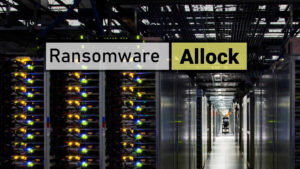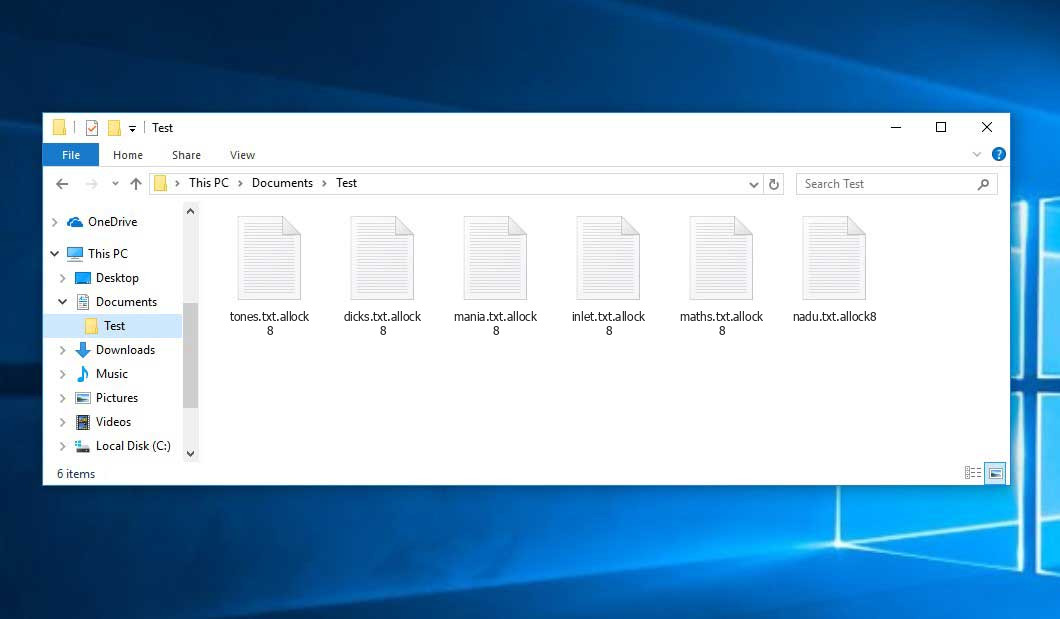The Allock virus falls under the MedusaLocker ransomware family. Malware of such sort encrypts all the data on your computer (photos, text files, excel sheets, music, videos, etc) and appends its extra extension to every file, creating the how_to_back_files.html files in every folder which contains the encrypted files.
What is Allock virus?
☝️ A scientifically correct denomination for the Allock is “a MedusaLocker family ransomware malicious agent”.
Allock will add its specific .allock8 extension to every file’s title. For example, an image entitled “photo.jpg” will be renamed to “photo.jpg.allock8”. Likewise, the Excel table with the name “table.xlsx” will end up as “table.xlsx.allock8”, and so on. The number at the end of the extension may vary depending on the malware sample.
In every directory containing the encoded files, a how_to_back_files.html file will be found. It is a ransom money memo. Therein you can find information about the ways of contacting the racketeers and some other information. The ransom note most probably contains a description of how to purchase the decryption tool from the racketeers. That is it.
Allock outline:
| Name | Allock Virus |
| Ransomware family1 | MedusaLocker ransomware |
| Extension | .allock8 |
| Ransomware note | how_to_back_files.html |
| Detection | Crytex.Virus.FileInfector.DDS, Win32/Filecoder.OLC, Malware-Cryptor.InstallCore.5 |
| Symptoms | Your files (photos, videos, documents) get a .allock8 extension and you can’t open them. |
| Fix Tool | See If Your System Has Been Affected by Allock virus |
In the picture below, you can see what a folder with files encrypted by the Allock looks like. Each filename has the “.allock8” extension added to it.
How did my computer get infected with Allock ransomware?
There are plenty of possible ways of ransomware injection.
There are currently three most exploited ways for malefactors to have the Allock virus planted in your digital environment. These are email spam, Trojan injection and peer-to-peer networks.
If you open your mailbox and see emails that look just like notifications from utility services providers, delivery agencies like FedEx, web-access providers, and whatnot, but whose “from” field is strange to you, beware of opening those emails. They are most likely to have a malicious item attached to them. Thus it is even more dangerous to download any attachments that come with emails like these.
Another option for ransom hunters is a Trojan horse scheme2. A Trojan is a program that gets into your PC pretending to be something different. For instance, you download an installer for some program you need or an update for some program. However, what is unboxed turns out to be a harmful agent that compromises your data. As the installation wizard can have any title and any icon, you’d better be sure that you can trust the source of the files you’re downloading. The best thing is to trust the software companies’ official websites.
As for the peer-to-peer file transfer protocols like torrent trackers or eMule, the danger is that they are even more trust-based than the rest of the Web. You can never know what you download until you get it. Our suggestion is that you use trustworthy resources. Also, it is reasonable to scan the folder containing the downloaded items with the anti-malware utility as soon as the downloading is complete.
How to remove the Allock virus?
It is crucial to inform you that besides encrypting your files, the Allock virus will probably deploy the Azorult Spyware on your machine to seize your credentials to different accounts (including cryptocurrency wallets). The mentioned program can extract your logins and passwords from your browser’s auto-filling cardfile.
Sometimes racketeers would decode some of your files to prove that they really have the decryption tool. As Allock virus is a relatively recent ransomware, safety measures developers have not yet found a way to undo its work. However, the decryption instruments are frequently upgraded, so the solution may soon arrive.
Understandably, if the criminals do the job of encrypting victim’s essential data, the hopeless person will most likely comply with their demands. However, paying to racketeers gives no guarantee that you’re getting your files back. It is still risky. After obtaining the ransom, the racketeers may send a wrong decryption code to the injured party. There were reports of racketeers just vanishing after getting the ransom without even bothering to reply.
The best countermeasure to ransomware is to have a system restore point or the copies of your critical files in the cloud storage or at least on an external storage. Surely, that might be insufficient. The most important thing could be that one you were working upon when it all happened. But at least it is something. It is also reasonable to scan your drives with the anti-malware utility after the OS restoration.
There are other ransomware products, besides Allock, that work similarly. For instance, Uyro, Uyit, Fate, and some others. The two main differences between them and the Allock are the ransom amount and the method of encryption. The rest is the same: files become blocked, their extensions changed, ransom notes emerge in each directory containing encoded files.
Some lucky people were able to decrypt the blocked files with the aid of the free software provided by anti-malware experts. Sometimes the hackers mistakenly send the decryption key to the victims in the ransom note. Such an extraordinary fail allows the victim to restore the files. But naturally, one should never rely on such a chance. Make no mistake, ransomware is a criminals’ instrument to pull the money out of their victims.
How do I avoid ransomware infection?
Allock ransomware has no endless power, so as any similar malware.
You can protect your system from ransomware injection within three easy steps:
- Ignore any emails from unknown mailers with strange addresses, or with content that has nothing to do with something you are expecting (how can you win in a money prize draw without even taking part in it?). In case the email subject is likely something you are waiting for, scrutinize all elements of the dubious email with caution. A hoax email will surely have a mistake.
- Do not use cracked or untrusted software. Trojan viruses are often shared as a part of cracked products, most likely as a “patch” which prevents the license check. Understandably, dubious programs are difficult to distinguish from trustworthy ones, as trojans sometimes have the functionality you seek. Try to find information about this program on the anti-malware forums, but the best solution is not to use such software.
- And finally, to be sure about the safety of the files you downloaded, check them with GridinSoft Anti-Malware. This program will be a powerful shield for your personal computer.
Reasons why I would recommend GridinSoft3
There is no better way to recognize, remove and prevent ransomware than to use an anti-malware software from GridinSoft4.
Download Removal Tool.
You can download GridinSoft Anti-Malware by clicking the button below:
Run the setup file.
When setup file has finished downloading, double-click on the setup-antimalware-fix.exe file to install GridinSoft Anti-Malware on your PC.

An User Account Control asking you about to allow GridinSoft Anti-Malware to make changes to your device. So, you should click “Yes” to continue with the installation.

Press “Install” button.

Once installed, Anti-Malware will automatically run.

Wait for the Anti-Malware scan to complete.
GridinSoft Anti-Malware will automatically start scanning your computer for Allock infections and other malicious programs. This process can take a 20-30 minutes, so I suggest you periodically check on the status of the scan process.

Click on “Clean Now”.
When the scan has completed, you will see the list of infections that GridinSoft Anti-Malware has detected. To remove them click on the “Clean Now” button in right corner.

FAQ
🤔 How can I open “.allock8” files?Are the “.allock8” files accessible?
There’s no way to do it, unless the files “.allock8” files are decrypted.
🤔 What should I do to make my files accessible as fast as possible?
If the “.allock8” files contain some really important information, then you probably have them backed up. Otherwise, you might try to employ System Restore. The only question is whether you have saved any Restore Points that would be helpful now. All other solutions require time.
🤔 If GridinSoft deletes the Allock malware, will it also delete my files that were encrypted?
No way! Your encrypted files are no threat to your PC.
GridinSoft Anti-Malware only deals with real threats. The virus that has infiltrated your computer is must be still active and running scans periodically to arrest any new files you might create on your computer after the infection. As it has been said above, the Allock malware comes with the company. It installs backdoors and keyloggers that can steal your account credentials and provide hackers with easy access to your system after some time.
🤔 What should I do if the Allock ransomware has blocked my computer and I can’t get the activation key.
In such an unfortunate situation, you need to prepare a flash memory card with a pre-installed Trojan Killer. Use Safe Mode to perform the cleaning. The point is that the ransomware starts automatically as the system launches and encrypts any new files created or imported into your PC. To suppress this function – use Safe Mode, which allows only the essential applications to run upon system start. Consider reading our manual on running Windows in Safe Mode.
🤔 What can I do right now?
Some of the encrypted files can be found elsewhere.
- If you sent or received your critical files by email, you could still download them from your online mailbox.
- You may have shared images or videos with your friends or relatives. Simply ask them to give those images back to you.
- If you have initially downloaded any of your files from the Internet, you can try downloading them again.
- Your messengers, social media pages, and cloud storage might have all those files as well.
- Maybe you still have the needed files on your old computer, a notebook, phone, memory stick, etc.
HINT: You can use data recovery programs5 to get your lost data back since ransomware encrypts the copies of your files, removing the authentic ones. In the tutorial below, you can learn how to use PhotoRec for such a recovery, but remember: you can do it only after you remove the virus with an anti-malware program.
Also, you can contact the following governmental fraud and scam sites to report this attack:
- In the United States: On Guard Online;
- In Canada: Canadian Anti-Fraud Centre;
- In the United Kingdom: Action Fraud;
- In Australia: SCAMwatch;
- In New Zealand: Consumer Affairs Scams;
- In France: Agence nationale de la sécurité des systèmes d’information;
- In Germany: Bundesamt für Sicherheit in der Informationstechnik;
- In Ireland: An Garda Síochána;
To report the attack, you can contact local executive boards. For instance, if you live in USA, you can have a talk with FBI Local field office, IC3 or Secret Service.
I need your help to share this article.
It is your turn to help other people. I have written this guide to help users like you. You can use the buttons below to share this on your favorite social media Facebook, Twitter, or Reddit.
Brendan SmithHow to Remove ALLOCK Ransomware & Recover PC

Name: ALLOCK Virus
Description: ALLOCK Virus is a ransomware-type infections. This virus encrypts important personal files (video, photos, documents). The encrypted files can be tracked by a specific .allock8 extension. So, you can't use them at all.
Operating System: Windows
Application Category: Virus
User Review
( votes)References
- My files are encrypted by ransomware, what should I do now?
- You can read more on Trojans, their use and types in the Trojan-dedicated section of GridinSoft official website.
- GridinSoft Anti-Malware Review from HowToFix site: https://howtofix.guide/gridinsoft-anti-malware/
- More information about GridinSoft products: https://gridinsoft.com/comparison
- Here’s the list of Top 10 Data Recovery Software Of 2023.


